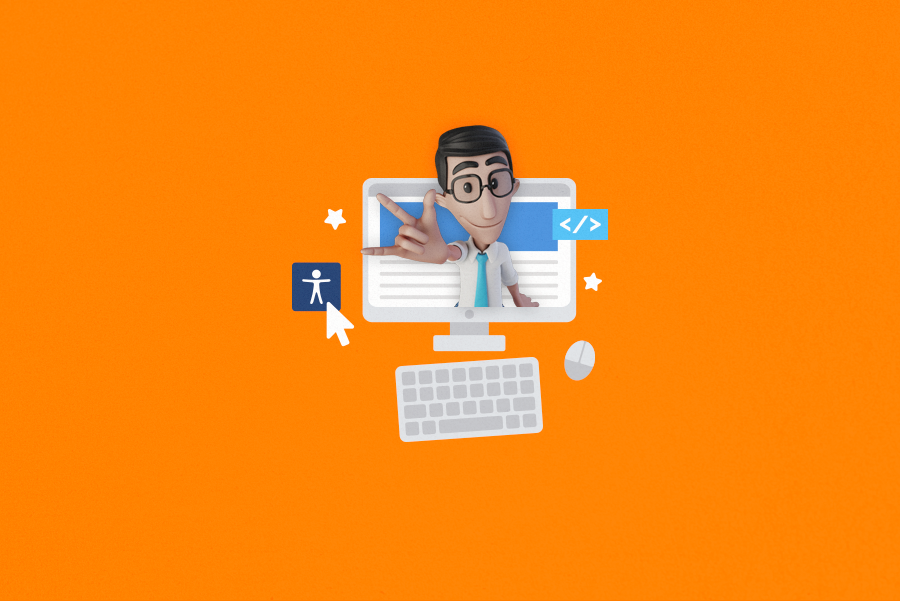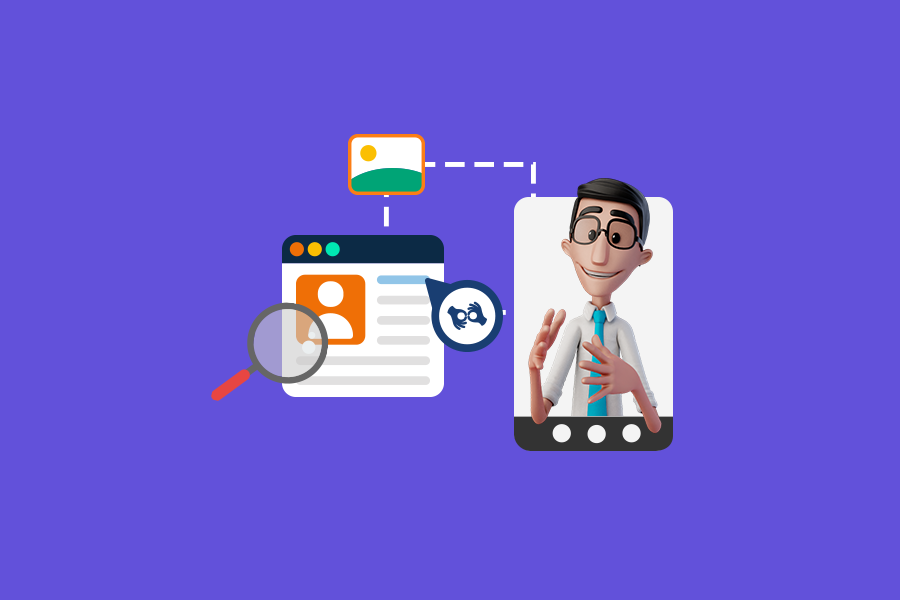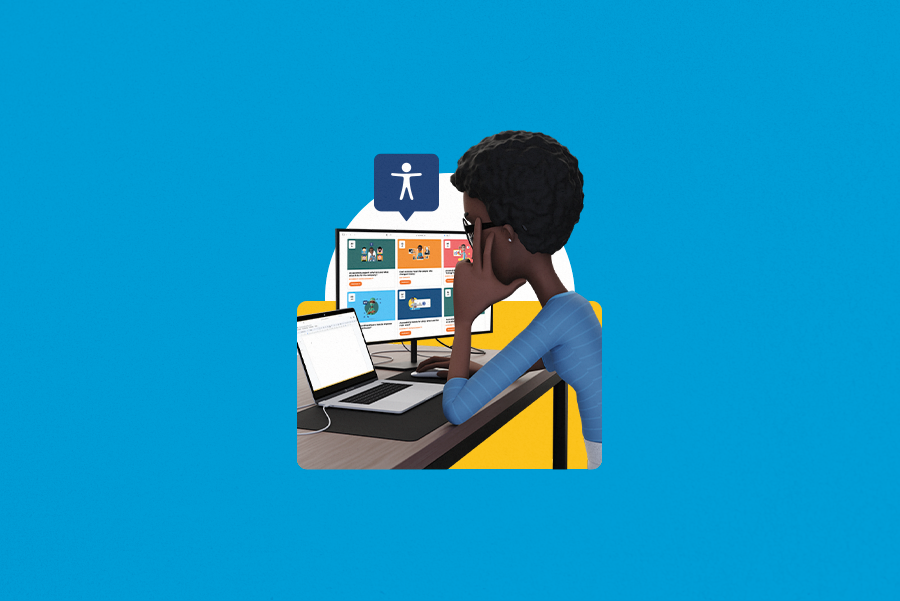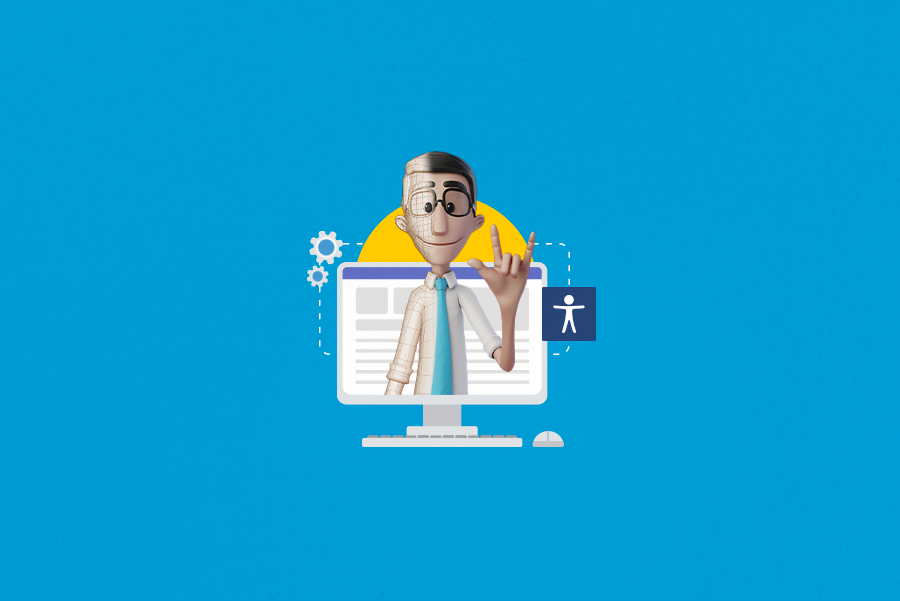
Technology and accessibility professionals: who are they?

Did you know that 27% of America’s population is made up of people with disabilities today? In addition to facing numerous barriers in offline daily life, this portion of the population also encounters various difficulties in navigating the web autonomously. And in a scenario where our lives are constantly intertwined with the digital space, it is essential to think about ways to make the online experience more accessible, right?
If you have been following us here, you know that digital accessibility is a topic that is gaining more and more attention and relevance in the market and in society. To meet this demand, technology and accessibility professionals are gradually becoming more valued in companies. Come learn more about the importance of these professionals and the relationship between technology and accessibility.
What is the relationship between technology and accessibility?
Technology can take on many different forms and is not necessarily tied to the digital world. In short, it encompasses all methods of evolution in any field.
In general, technology helps us automate processes and facilitate everyday actions. And of course, we cannot even imagine our lives without the presence of technology today, especially related to the digital space.
With this in mind, it is not too difficult to understand the relationship between technology and accessibility, is it? By combining these two areas, we find tools to make society and its physical and virtual spaces more accessible.
People with disabilities have been occupying more and more spaces, which need to be accessible for them to have their experiences and lives to the fullest. Technology has been a great ally in this process. It is also worth remembering that accessibility benefits everyone!
How can technology help with accessibility?
The main result that emerged from the combination of technology and accessibility was assistive technologies. There are countless devices, software, and tools today that fall under this category.
But what exactly is an assistive technology? It can be described as services and resources aimed at people with disabilities, with the goal of providing them with more independence, quality of life and social inclusion.
In fact, this is a market that is growing more and more and is expected to reach up to $31 billion by 2024. So, how about delving deeper into some examples of assistive technologies and how to integrate them into your business?
What are some examples of assistive technologies?
As we mentioned before, assistive technologies are not exclusive to the digital environment. You definitely already know several examples, but you might not have realized that they are assistive technologies.
Imagine you are walking down the street. Now try to think about all the assistive technologies you might encounter on that walk. The ramps on the sidewalks are an example, designed to promote accessibility for those who use wheelchairs, which is also another example. We also have tactile paving, those raised strips on the ground that help people with visual impairments walk more autonomously.
When we enter the digital world, we also encounter screen readers, software that translates speech to text or vice versa, Sign Languages translators, among others. Even keyboard shortcuts and captions are assistive technologies!
A cool thought to consider is that these tools, besides being essential for those with permanent disabilities, are also extremely useful for people with temporary or situational disabilities. For example, captions. They are crucial for people with hearing disabilities. At the same time, they allow someone who is on public transportation, and is not able to increase the volume of their phone, to consume video content.
Who are the technology and accessibility professionals?
Assistive technologies are incredible and excellent tools for promoting accessibility and social inclusion. But to make them available to the public, we need people who develop them, right? This is where technology and accessibility professionals come in!
We will show you some examples of common roles in large companies and their main functions. This way, you can start learning more about the field and even find a specialization that best suits your profile. Here we go!
Lead Accessibility
You would be responsible for establishing and guiding technical and design standards across all platforms of the company, both internal and external. You also need to define and disseminate accessible best practices throughout the organization’s team. Typically, you need previous experience in technology and design solutions, with a focus on digital accessibility, policies and legislation.
Accessibility Director
To be an Accessibility Director, as it is a more senior role, you need a broad view of all the company’s products and services to ensure that they are being used in the best possible way by users and employees with disabilities. You also need to have a strong mastery of accessibility and ideally have connections with communities of people with disabilities. All of this is important for helping shape the best accessibility practices in the organization and the market as a whole.
Manager Accessibility Experience
For this role, you are expected to be capable of conducting multiple manual tests with assistive technology software and hardware, as well as advising product teams on accessible UX/UI design. Your ultimate goal is to identify accessibility issues and present solutions for them, creating pleasant, efficient and productive experiences for all users with disabilities.
Chief Accessibility
To be a Chief Accessibility, understand that you will be responsible for the vision, strategy and execution of inclusive and accessible products. This is also a more senior role, so you are also expected to play a leading part in the market regarding accessibility, setting the best practices and success metrics. Having experience with design, product management and customer service, all focused on accessibility, is ideal.
Product Manager Accessibility
Here, you will be responsible for the company’s accessibility culture, ensuring that all involved teams follow the strategic plan when implementing accessibility elements. It is important to have experience with accessibility processes and product management.
Accessibility Programs Director
For this position, it is important to have a good understanding of global accessibility programs. It might also require experience with developing and implementing accessible programs in the past.
Change Coordinator Accessibility
Here, you will be responsible for coordinating the entire accessibility lifecycle of the product and the expert professionals in each process. It is important to have experience with developing accessibility projects, as well as mastering various techniques and tools in the field.
UX Research Accessibility
You will perform functions similar to those of a regular UX Designer but will focus on the accessibility aspect of the user experience. You need experience in conducting research and familiarity with accessibility tools and assistive technology.
Digital Accessibility Manager
In this role, you will be a digital accessibility expert and act as a kind of Product Manager, interacting with different teams within the company. For this, you need to deeply understand how people with different disabilities and needs interact with your product to ensure the best accessibility and usability for them.
Process Manager Digital Accessibility
Here, you need a solid understanding of accessibility and inclusive design to apply this knowledge to the development processes throughout the product lifecycle. And of course, experience with accessibility tools is crucial.
What are the knowledge levels to become an accessibility expert?
First and foremost, you need to understand that continuous learning is essential to becoming an accessibility expert. Go after courses, certifications and, most importantly, practical experiences to identify where you need to improve.
Aside from that, we have listed some skills that can help you deepen your knowledge in this area:
- Gaining a deep understanding of the realities of people with disabilities;
- Being able to present convincingly to different audiences;
- Being capable of teaching and learning quickly;
- Having experience in software engineering, programming, web development or UX/UI design.
Conclusion
Regardless of your role within a company, it is important to know that accessibility is everyone’s responsibility! However, as a technology and accessibility professional, promoting an accessible culture in the organizations you are a part of will always be one of your main responsibilities.
Are you interested in delving deeper into the world of accessibility? Then follow Hand Talk’s blog! Here you will find plenty of interesting content on the subject, tips on implementing accessibility in practice and examples of multiple assistive technologies. Check it out!


